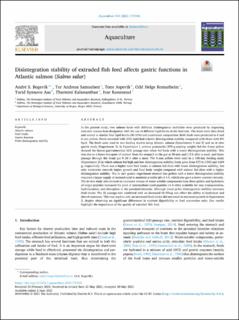| dc.description.abstract | In the present study, two salmon feeds with different disintegration stabilities were produced by impacting extruder viscous heat dissipation with the use of different lipid levels in the feed mix. The feeds were then dried and coated to similar final lipid levels (30-31%) and nutritional composition. Both feeds were produced as 4 and 6-mm pellets. Feeds extruded with 20% lipid had a lower disintegration stability compared with those with 8% lipid. The feeds were used in two feeding studies using Atlantic salmon (Experiments 1 and 2) and an in vitro gastric study (Experiment 3). In Experiment 1, salmon postsmolts (370 g starting weight) fed the 4-mm pellets showed the fastest gastrointestinal (GI) passage rate when fed feeds with a lower disintegration stability. This was due to a faster transport of content from the stomach to the gut at 30 min and 1.5 h after a meal, and faster passage through the distal gut 9–24 h after a meal. The 6-mm pellets were used in a 100-day feeding study (Experiment 2) in which salmon fed high and low disintegration stability feeds grew from 572 to 1542 and 1604 g, respectively. There was a higher total feed intake in salmon fed diets with lower disintegration stability, but only tendencies towards higher growth and final body weight compared with salmon fed diets with a higher disintegration stability. The in vitro gastric experiment showed that pellets with a lower disintegration stability required a larger supply of stomach acid to maintain a stable pH of 4.5, which also gave a lower content viscosity. The in vitro study also showed an increased release of water-soluble components from these pellets and hydrolysis of larger peptides increased the pool of intermediate-sized peptides (4–6 kDa) available for easy transportation, hydrolyzation, and absorption in the proximal intestine. Although lower pellet disintegration stability increases feed intake. The GI passage rate combined with an increased GI filling can affect the ability to hydrolyze and absorb nutrients. This may explain why an increased feed intake did not result in increased growth in Experiment 2, despite observing no significant differences in nutrient digestibility or feed conversion ratio. Our results highlight the importance of the quality of extruded fish feed. | |
